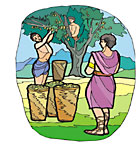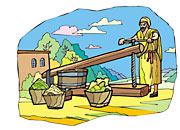by Marjorie Dorfman
Olive oil is many things to many people. It was well known in the ancient world and dates back some twenty million years, although actual cultivation of the olives probably did not occur until the fifth century BC. Read all about this noble unguent and its endless source of health, power, fascination and wonder.
Olive Oil and The Ancient World
 The olive tree is native to the Mediterranean basin and it is known that Neolithic people as early as the 8th millennium BC collected wild olives. Before 2000 BC Egyptians imported olive oil from Crete, Syria and Canaan, and olive oil was considered a symbol of importance and wealth. One tomb over 4,000 years old on the island of Naxos in the Aegean Sea yielded jugs containing the remains of olive oil. Sinuhe, the Egyptian exile who lived in northern Canaan about 1960 BC, provides written record of abundant olive trees.
The olive tree is native to the Mediterranean basin and it is known that Neolithic people as early as the 8th millennium BC collected wild olives. Before 2000 BC Egyptians imported olive oil from Crete, Syria and Canaan, and olive oil was considered a symbol of importance and wealth. One tomb over 4,000 years old on the island of Naxos in the Aegean Sea yielded jugs containing the remains of olive oil. Sinuhe, the Egyptian exile who lived in northern Canaan about 1960 BC, provides written record of abundant olive trees.There are two main theories concerning the very first cultivation of olives, and many experts agree that it occurred before 4,000 BC on the island of Crete. The earliest surviving olive oil amphorae date back to early Minoan times (3500 BC). Other historians assert that olives were turned into oil by 4500 BC by Canaanites in present-day Israel.
It is known for sure that over 5,000 years ago olive oil was extracted from olives in the Eastern Mediterranean. In the centuries that followed, olive presses could be found in abundance from the Atlantic shore of North Africa to Persia, and from the Po Valley to the settlements along the Nile. Many ancient presses still exist in the Eastern Mediterranean region, and some dating to the Roman period are still in use today.
Homer called olive oil “liquid gold” and the athletes of his day ritually rubbed it all over their bodies. Olive oil is mentioned in the Bible in the 23rd Psalm, (Thou anointeth my head with oil) and has been an almost mystical force down through history. Ancient saints and martyrs were buried with holes in their tombs specifically so that drops of olive oil seeped into their bones, preparing them for some grand and mysterious afterlife.
 In the cultures surrounding the Mediterranean Sea particularly, olive oil has been much more than just food. Medicinal and magical, the olive tree is a symbol of abundance, glory and peace. Its branches crowned the victorious in both games and battle, and the oil of this fruit has anointed the noblest of heads throughout history. Even the tomb of King Tutankhamen contained olive crowns and branches; symbols proffered to a glorified king in ritual splendor.
In the cultures surrounding the Mediterranean Sea particularly, olive oil has been much more than just food. Medicinal and magical, the olive tree is a symbol of abundance, glory and peace. Its branches crowned the victorious in both games and battle, and the oil of this fruit has anointed the noblest of heads throughout history. Even the tomb of King Tutankhamen contained olive crowns and branches; symbols proffered to a glorified king in ritual splendor.Olive trees were planted in the entire Mediterranean basin during the evolution of the Roman republic and empire. Olive oil was a staple of Hellenic and Latin cuisine. According to legend, the city of Athens was so named because the offering of the goddess, Athena was an olive tree. It won over the offering of Poseidon, which was a spring of salt water gushing out of a cliff.
In the ancient city-state of Sparta, athletes rubbed themselves with olive oil while exercising in the gymnasia. This ritual, so often depicted in ancient murals, eroticized and highlighted the beauty of the male body. From the seventh century BC, the decorative use of olive oil quickly spread to all of the Hellenic city-states.
 In the eight century BC as the Greek colonies expanded, olive culture reached Southern Italy and Northern Africa and then spread into Southern France. The Romans filled the Mediterranean basin with olive trees and according to historian, Pliny, Italy had “the best oil in the Mediterranean at reasonable prices.”
In the eight century BC as the Greek colonies expanded, olive culture reached Southern Italy and Northern Africa and then spread into Southern France. The Romans filled the Mediterranean basin with olive trees and according to historian, Pliny, Italy had “the best oil in the Mediterranean at reasonable prices.”Olive trees were almost sacred in the land of the Hebrews where King David employed guards to watch over the olive groves and warehouses and ensure the safety of their most precious olive oil. In ancient Hellenic society, olive trees dominated the Greek countryside, and anyone who cut them down risked death or exile. Olive oil was the hottest export in both the Roman and Greek cultures and special ships transported the oil to the various trading posts along the Mediterranean.
Ancient Beliefs Concerning Olive Oil
It was a common belief in the ancient world that olive oil conferred strength and youth. In the cultures of Egypt, Greece, and Rome, in order to produce both medicine and cosmetics the oil was often infused with flowers and grasses. In an excavation at Mycenae, a list was found, which enumerated the aromatics added to olive oil in the preparation of ointments. These included: fennel, sesame, celery, watercress, mint, sage, rose, and juniper among others.
 Olive oil served a myriad of purposes in ancient civilization. Used in religious rituals, medicines, as fuel for oil lamps, soap making and skin application. (This is in addition to food, of course.) Even the derivation of the word, oil, denotes its significance. It may derive from the Greek elaion (olive tree), but more are inclined to think that it comes from the Semitic/Phoenician use of the word, el’yon, which means ‘superior.’ This indicates an implied comparison to other vegetable or animal fats available at the time.
Olive oil served a myriad of purposes in ancient civilization. Used in religious rituals, medicines, as fuel for oil lamps, soap making and skin application. (This is in addition to food, of course.) Even the derivation of the word, oil, denotes its significance. It may derive from the Greek elaion (olive tree), but more are inclined to think that it comes from the Semitic/Phoenician use of the word, el’yon, which means ‘superior.’ This indicates an implied comparison to other vegetable or animal fats available at the time.Olive oil symbolized healing and strength and consecration. It was God’s way of setting a person or place apart for special work. This may or may not be related to its use as a medicinal agent and for cleansing athletes by slathering them in olive oil and then scraping them off.
Religious Significance of Olive Oil
 Ancient Jews, Muslims and Christians all held olive oil in great esteem. In Jewish observance, olive oil is the only fuel allowed for use in the nine-branched Menorah. Obtained by using only the first drop from a squeezed olive, it was then consecrated and stored in special containers for use only in the Temple. Although candles are permitted, oil containers are preferred, because they imitate the original Menorah. Another use of oil in Jewish religion is for anointing the kings of the Kingdom of Israel, a ritual dating back to the days of King David.
Ancient Jews, Muslims and Christians all held olive oil in great esteem. In Jewish observance, olive oil is the only fuel allowed for use in the nine-branched Menorah. Obtained by using only the first drop from a squeezed olive, it was then consecrated and stored in special containers for use only in the Temple. Although candles are permitted, oil containers are preferred, because they imitate the original Menorah. Another use of oil in Jewish religion is for anointing the kings of the Kingdom of Israel, a ritual dating back to the days of King David.In the Catholic and Orthodox churches of the world, olive oil was used to bless and strengthen those preparing for baptism. For rituals such as Baptism and Confirmation, it was mixed with balsam or some other perfuming agent and consecrated by bishops. Eastern Orthodox Christians still use ‘vigil lamps,’ which consist of a votive glass containing a half-inch of water, the rest of which is filled with olive oil. The glass’s metal holder either hangs from a bracket on the wall or sits on a table. A cork float with a lit wick floats on the oil. To douse the flame, the float is carefully pressed down into the oil.
 In Islam, olive oil is mentioned in the holy verse of the Qur’an (Koran). It states: “God is the light of heavens and earth. An example of His light is like a lantern inside which there is a torch, the torch is in a glass bulb, the glass bulb is like a bright planet lit by a blessed olive tree, neither Eastern nor Western, its oil almost glows, even without fire touching it, light upon light.”
In Islam, olive oil is mentioned in the holy verse of the Qur’an (Koran). It states: “God is the light of heavens and earth. An example of His light is like a lantern inside which there is a torch, the torch is in a glass bulb, the glass bulb is like a bright planet lit by a blessed olive tree, neither Eastern nor Western, its oil almost glows, even without fire touching it, light upon light.”The Koran further makes reference to olives as a sacred plant in the quote: “By the fig and the olive, and the Mount of Sinai, and this secure city.”
Muhammad himself was reported to have stated that olive oil cures some 70 diseases. He recommended the use of olive oil in the following ways: “Consume olive oil and anoint it upon your bodies since it is of the blessed tree.”
How Olive Oil is Made
 The most traditional way of making olive oil is by simply grinding olives. Special care is taken to insure that the olives are perfectly ripened, as over-ripeness produces a rancid oil. First the olives are ground into paste using large millstones. The olive paste generally stays under the stones for 30–40 minutes. The oil collected during this part of the process is called virgin oil. After grinding, the olive paste is spread on fiber disks, which are stacked on top of each other, then placed into the press. Pressure is then applied onto the disk to further separate the oil from the paste. This second step produces a lower grade of oil.
The most traditional way of making olive oil is by simply grinding olives. Special care is taken to insure that the olives are perfectly ripened, as over-ripeness produces a rancid oil. First the olives are ground into paste using large millstones. The olive paste generally stays under the stones for 30–40 minutes. The oil collected during this part of the process is called virgin oil. After grinding, the olive paste is spread on fiber disks, which are stacked on top of each other, then placed into the press. Pressure is then applied onto the disk to further separate the oil from the paste. This second step produces a lower grade of oil.Modern Consumption of Olive Oil
Most of the global production of olive oil comes from southern Europe, North Africa and the Middle East. Of the more than 750 million olive trees that are cultivated worldwide, 95 percent are located in the Mediterranean region. Greece devotes 60% of its cultivated land to olive growing. It is the world’s top producer of black olives and has more varieties of olives than any other country. Greece exports mainly to European Union (EU) countries, mostly Italy. Olives are grown for oil in mainland Greece, with Peloponnesus being the source of 65% of Greek production, as well as in Crete, the Aegean Islands and Ionian Islands.





























0 comments:
Post a Comment